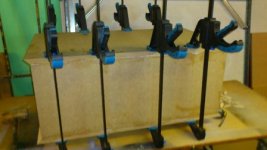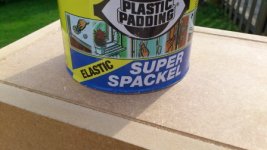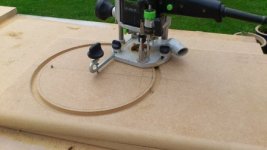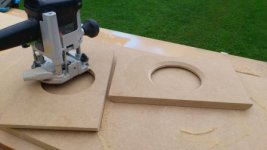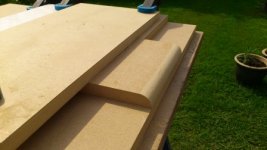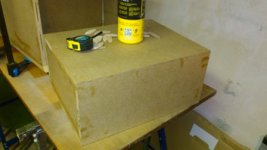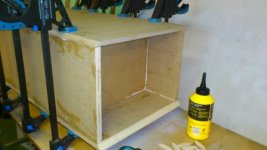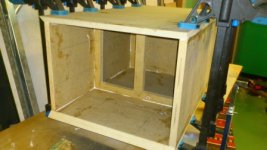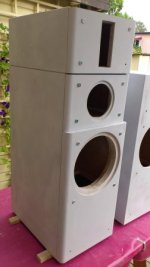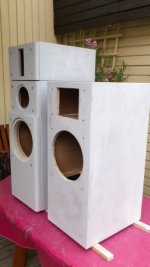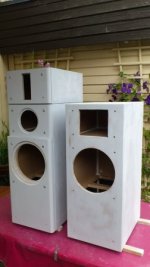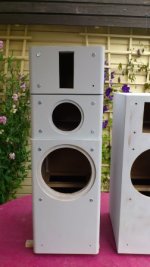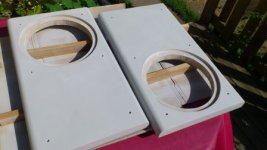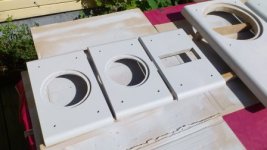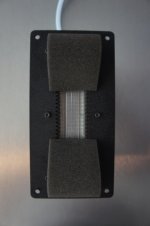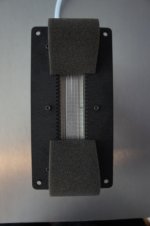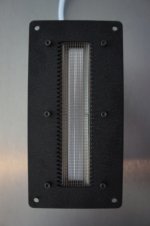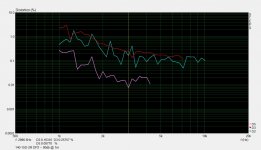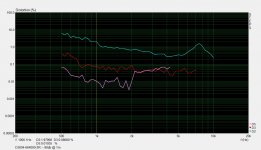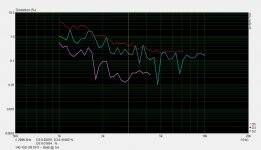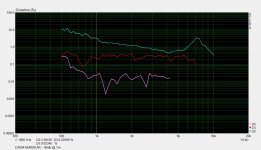Hi everyone,
I’ve started the "Sequence Three – Grand Reference" enclosure construction and I will continue to report about the building progress as it proceeds.
Sequence Three – Grand Reference Construction!
Sequence Three – Grand Reference Construction Update1!
The "Sequence Three – Grand Reference" enclosure is made of two parts, one which contains the tweeter and the cross-over and one which contains the mid-woofer and the woofer. The top tweeter enclosure can slide back and forth in order to be able to adjust the acoustical off-set between the tweeter and mid-woofer, if needed in the design.
The loudspeaker enclosure uses a baffle replacement system in order to be able to swap drivers in and out as needed and at the same time make the enclosure somewhat future proof.
The overall enclosure dimension is (WxHxD) 33x105x43cm incl. feets + baffle thickness. The tweeter and mid-woofer replacement baffle is 19mm thick, while the woofer baffle is 38mm thick.
The tweeter + cross-over enclosure is 33x20x43cm + the tweeter baffle. The mid-woofer and woofer enclosure are 33x78x43cm + the baffles. The two bass-reflex ports are mounted in the bottom of the enclosure. The enclosure feet’s are 7cm high including the “Sonic Design” damping feet’s.
All internal walls are covered with 4mm bitumen pads as well as bracings for the mid-woofer and woofer section.
The woofer net volume is about 64 liter minus the volume for the bracing, bitumen pads, bass-reflex ports and driver, which gives approximately 55-56 liter for the woofer to work in. The mid-woofer and tweeter sections are about 18 liter volume each.
Picture 1: Mid-woofer and woofer enclosure.
Picture 2: Woofer section.
Picture 3: Mid-woofer section.
Picture 4: Tweeter and cross-over enclosure.
Picture 5: Round-over jig.
Picture 6: Mid-woofer chamfering.
Picture 7: Woofer routing and flush-mount cutout.
Picture 8: Milled groove to be filled with elastic filler for invisible MDF board joints.
Regards
/Göran
I’ve started the "Sequence Three – Grand Reference" enclosure construction and I will continue to report about the building progress as it proceeds.
Sequence Three – Grand Reference Construction!
Sequence Three – Grand Reference Construction Update1!
The "Sequence Three – Grand Reference" enclosure is made of two parts, one which contains the tweeter and the cross-over and one which contains the mid-woofer and the woofer. The top tweeter enclosure can slide back and forth in order to be able to adjust the acoustical off-set between the tweeter and mid-woofer, if needed in the design.
The loudspeaker enclosure uses a baffle replacement system in order to be able to swap drivers in and out as needed and at the same time make the enclosure somewhat future proof.
The overall enclosure dimension is (WxHxD) 33x105x43cm incl. feets + baffle thickness. The tweeter and mid-woofer replacement baffle is 19mm thick, while the woofer baffle is 38mm thick.
The tweeter + cross-over enclosure is 33x20x43cm + the tweeter baffle. The mid-woofer and woofer enclosure are 33x78x43cm + the baffles. The two bass-reflex ports are mounted in the bottom of the enclosure. The enclosure feet’s are 7cm high including the “Sonic Design” damping feet’s.
All internal walls are covered with 4mm bitumen pads as well as bracings for the mid-woofer and woofer section.
The woofer net volume is about 64 liter minus the volume for the bracing, bitumen pads, bass-reflex ports and driver, which gives approximately 55-56 liter for the woofer to work in. The mid-woofer and tweeter sections are about 18 liter volume each.
Picture 1: Mid-woofer and woofer enclosure.
Picture 2: Woofer section.
Picture 3: Mid-woofer section.
Picture 4: Tweeter and cross-over enclosure.
Picture 5: Round-over jig.
Picture 6: Mid-woofer chamfering.
Picture 7: Woofer routing and flush-mount cutout.
Picture 8: Milled groove to be filled with elastic filler for invisible MDF board joints.
Regards
/Göran
Attachments
A brief update:
The work is proceeding as planned even though it has been delayed a bit by bad weather. Unfortunately the Swedish summer weather is a bit unpredictable.
Lately the work has mostly been – sand, fill, sand, fill, sand, fill, sand……… I almost forgot how boring I think sanding is.
Currently I’m working on the loudspeaker foot as well as attaching additional bracing and damping of the woofer section. I’m also planning for the spray painting of the baffles and some parts of the enclosure. The final finishing of the loudspeaker isn’t 100% decided yet.
Sequence Three – Grand Reference Construction!
Sequence Three – Grand Reference Construction Update1!
Sequence Three – Grand Reference Construction Update2!
Picture1: Mid-woofer and Tweeter baffles.
Picture2: Woofer baffles.
Picture3-6: The left loudspeaker shows the tweeter/cross-over enclosure and the baffles, excluding the loudspeaker foot. The right loudspeaker shows the mid/woofer enclosure without baffles.
Regards
/Göran
The work is proceeding as planned even though it has been delayed a bit by bad weather. Unfortunately the Swedish summer weather is a bit unpredictable.
Lately the work has mostly been – sand, fill, sand, fill, sand, fill, sand……… I almost forgot how boring I think sanding is.
Currently I’m working on the loudspeaker foot as well as attaching additional bracing and damping of the woofer section. I’m also planning for the spray painting of the baffles and some parts of the enclosure. The final finishing of the loudspeaker isn’t 100% decided yet.
Sequence Three – Grand Reference Construction!
Sequence Three – Grand Reference Construction Update1!
Sequence Three – Grand Reference Construction Update2!
Picture1: Mid-woofer and Tweeter baffles.
Picture2: Woofer baffles.
Picture3-6: The left loudspeaker shows the tweeter/cross-over enclosure and the baffles, excluding the loudspeaker foot. The right loudspeaker shows the mid/woofer enclosure without baffles.
Regards
/Göran
Attachments
Hi
Looks very impressive
Why not use the bass unit in a TL as Troels has done?
Regards
Jozua
Thank you!
Why would I build my speaker exactly as Troels?
Seriously, in fact a TL solution had required a larger enclosure than I wanted in my design. The bass-reflex solution will work well with this woofers and I think even Troels have used this woofer in a BR design. According to my measurements/simulations on the AT woofer, the Troels used and suggested enclosure volume for it in a BR solution seems optimal for it.
Regards
/Göran
I'm looking forwards to see how this progresses, especially if you give us detailed driver measurements as you have in the past. There is a distinct lack of good measurements on the RAAL and AT drivers so it would be very useful if you did
Measuring Raal 140-15D
I didn't find that 140-15D all that great. Aside from high second order harmonic, it's very directional vertically (as any tall ribbons) even with the foam pads. Smaller Raal are better performers, less directional all tho pricing is insane.
With the name like "Grand Reference" I suppose, frequency response should be within 2-3db and that's not going to be so easy to do with 140-15d.
I'm looking forwards to see how this progresses, especially if you give us detailed driver measurements as you have in the past. There is a distinct lack of good measurements on the RAAL and AT drivers so it would be very useful if you did
Yes, of course. There will be a lot of measurements and probably more than usual.
Measuring Raal 140-15D
I didn't find that 140-15D all that great. Aside from high second order harmonic, it's very directional vertically (as any tall ribbons) even with the foam pads. Smaller Raal are better performers, less directional all tho pricing is insane.
With the name like "Grand Reference" I suppose, frequency response should be within 2-3db and that's not going to be so easy to do with 140-15d.
Hi R-Carpenter,
Thank you for sharing your experience with the RAALs. I’ve read some of your comments before regarding the RAALs, but I don’t judge them before I myself have measured and listen to them in a loudspeaker design. Measurements is one thing, how it actually sounds is another…
Yes, I agree the RAALs are very expensive, but in my case I bought them second-hand and replaced the ribbons with new ones.
I’m not too worried about some elevated second-order harmonics, many domes have the same behavior. The vertical dispersion is another thing and the effect of the foam pads will be very interesting to measure.
Naming a speaker to something meaningful is always hard, but in this case the “Grand” stands for a large floor-stander and “Reference” stands for the use of more exclusive drivers and custom built cabinets (not pre-fab Dayton cabs).
The loudspeaker will first be setup in an active configuration with my DEQX HDP-3 pre-amp and the frequency linearity in this setup will probably be better than +/- 0.25db, if I so wishes.
Regards
Göran
interesting build i'll follow this project!
which kind of amplifier are you gonna use with such high end drivers and dsp since you're going active?
Usually when I go active with the DEQX HDP-3 I’m using 3x PopPulse T-150 class-T power amps. Don’t be discouraged by the low price of these amps. When used as pure power-amps with the volume control by-passed they sound very good, much better than the price suggests. Yes, they are a bit power limited, about 50W @ 8Ohms and 90W @ 4Ohms, but they sound more powerful than they should for the price and they have the bass in a firm grip and they do sound very musical and pleasant.
Definitely one of the best Hifi equipment bargains I’ve done.
I also have more powerful multi-channel class-AB amps from Kinergetics Research as well as tube-amps and other pre-amps. I have a wide variety of pre-amps, power-amps and DACs etc. in order to test and listen to my loudspeakers in different setups.
Regards
/Göran
Thank you!
Why would I build my speaker exactly as Troels?
Seriously, in fact a TL solution had required a larger enclosure than I wanted in my design. The bass-reflex solution will work well with this woofers and I think even Troels have used this woofer in a BR design. According to my measurements/simulations on the AT woofer, the Troels used and suggested enclosure volume for it in a BR solution seems optimal for it.
Regards
/Göran
Goran
I suspect the TL would go down deeper and also be stronger with all the internal bracing.
I am considering importing the Audio Tech bass drivers for Troels Jenzen Accu project. Your experiences with these drivers will be quite helpfull to me and yes the DEQX is possibly a good option considering the high cost of top end X-over components.
Regards
Jozua
Last edited:
Hi R-Carpenter,
Thank you for sharing your experience with the RAALs. I’ve read some of your comments before regarding the RAALs, but I don’t judge them before I myself have measured and listen to them in a loudspeaker design. Measurements is one thing, how it actually sounds is another…
Yes, I agree the RAALs are very expensive, but in my case I bought them second-hand and replaced the ribbons with new ones.
I’m not too worried about some elevated second-order harmonics, many domes have the same behavior. The vertical dispersion is another thing and the effect of the foam pads will be very interesting to measure.
Naming a speaker to something meaningful is always hard, but in this case the “Grand” stands for a large floor-stander and “Reference” stands for the use of more exclusive drivers and custom built cabinets (not pre-fab Dayton cabs).
The loudspeaker will first be setup in an active configuration with my DEQX HDP-3 pre-amp and the frequency linearity in this setup will probably be better than +/- 0.25db, if I so wishes.
Regards
Göran
Hi Göran
Certainly not an easy integration between a largish mid-range driver and a ribbon with a very specific directive pattern and pass-band.
Interesting and challenging project. Looking forward to your Raal data.
Also, if it's physically possible at all, I'd increase measurement baffle size to at list 1mx1m
In the future, will you be splicing near field low end data of woofers and mid-wofers?
Last edited:
When it comes to vertical dispersion I personally feel that it is one of the less important things to consider when designing a loudspeaker. Certainly you want to ensure that the primary lobe is large enough so that you aren't going to be confronted with a large suck-out even anywhere remotely close to your listening position. But beyond that, even limiting the vertical dispersion could really perhaps be seen as a good thing as less energy thrown out into the room = less problems that you could possibly encounter with the room.
Lots of people do have trouble with highly reflective and somewhat reverberant sound fields, especially in some of todays more modern styled houses and I can only see that limiting the vertical dispersion in those situations to be of benefit to the overall sound.
It will be interesting to see how you approach the crossover Gornir, as anyone can see that a lower rather then higher xover point would be more suited given the constraints of the large ribbon format, but some have said how much nicer the ribbbon sounds when crossed over higher. The audiotech midrange at least has the flexibility to allow you to play around considerably with this.
Lots of people do have trouble with highly reflective and somewhat reverberant sound fields, especially in some of todays more modern styled houses and I can only see that limiting the vertical dispersion in those situations to be of benefit to the overall sound.
It will be interesting to see how you approach the crossover Gornir, as anyone can see that a lower rather then higher xover point would be more suited given the constraints of the large ribbon format, but some have said how much nicer the ribbbon sounds when crossed over higher. The audiotech midrange at least has the flexibility to allow you to play around considerably with this.
Lots of people do have trouble with highly reflective and somewhat reverberant sound fields, especially in some of todays more modern styled houses and I can only see that limiting the vertical dispersion in those situations to be of benefit to the overall sound.
I agree. Despite some areas of average measured performance the RAAL has a combination of attributes that make it a nice driver to listen to. I'd nearly always rate it well regardless.
Great work Gornir.
Nice to see the RAAL being put back into service.
Thank you!
I hope I enjoy them as much as you did and I'm eager to see how they perform.
Regards
/Göran
When it comes to vertical dispersion I personally feel that it is one of the less important things to consider when designing a loudspeaker. Certainly you want to ensure that the primary lobe is large enough so that you aren't going to be confronted with a large suck-out even anywhere remotely close to your listening position. But beyond that, even limiting the vertical dispersion could really perhaps be seen as a good thing as less energy thrown out into the room = less problems that you could possibly encounter with the room.
Lots of people do have trouble with highly reflective and somewhat reverberant sound fields, especially in some of todays more modern styled houses and I can only see that limiting the vertical dispersion in those situations to be of benefit to the overall sound.
It will be interesting to see how you approach the crossover Gornir, as anyone can see that a lower rather then higher xover point would be more suited given the constraints of the large ribbon format, but some have said how much nicer the ribbbon sounds when crossed over higher. The audiotech midrange at least has the flexibility to allow you to play around considerably with this.
You are a wise man 5th element. I think we agree on most things so far.
The vertical dispersion is something to keep an eye on, but the importance of it shouldn’t be exaggerated as long as it’s large enough at listening height/position and without large suck-outs within your listening window.
I hope I can get away with a cross-over point around 3kHz, but the measurements will tell what’s feasible.
Regards
/Göran
Hi Göran
Certainly not an easy integration between a largish mid-range driver and a ribbon with a very specific directive pattern and pass-band.
Interesting and challenging project. Looking forward to your Raal data.
Also, if it's physically possible at all, I'd increase measurement baffle size to at list 1mx1m
In the future, will you be splicing near field low end data of woofers and mid-wofers?
Unfortunately, at the moment I don’t have any room for storing and handling a large infinite baffle for measurements. Instead I made the choice to do all my measurements in real enclosures and when I publish the results I try to describe the measurement conditions carefully.
In this way people can at least see how the drivers perform on a baffle in normal enclosure sizes and I presume that those who have the knowledge to design their own loudspeakers will do their own measurements anyway.
Also, I wouldn’t use anyone else’s measurement data for one of my own designs, but other people’s measurements can be helpful to evaluate and select drivers for your own testing and measurements.
I do sometimes splice near field low end data of woofers for my own use, but I haven’t published it in any of my designs yet. It’s very time consuming to publish all designs and measurements and so far I have chosen not to because I think it’s of less importance. I might perhaps change that in the future if there is a large interest in it.
/Regards
/Göran
RAAL 140-15D Measurements!
Hi everyone,
Here’s an update on the progress of the Sequence Three – Grand Reference loudspeaker design.
Sequence Three – Grand Reference -- Construction Blog
RAAL 140-15D Measurements!
I’ve made some extensive measurements on the RAAL 140-15D ribbon tweeter and before the measurements I installed brand new replacement ribbons in both the RAAL tweeter samples and tightened up the ribbons as in this instruction video from RAAL.
RAAL Ribbon Replacement and Tightening -- YouTube
As instructed, it worked perfectly.
Since it’s possible to shape the frequency response both vertically and horizontally with the supplied “foam deflection pads”, it seemed as the tweeter measurement setup could almost be done in an infinite number of variations.
I finally decided and ended up with the following tweeter configurations:
Picture1: DPN = No “deflection pads”.
Picture2: DP1 = With “deflection pads” and 7cm visible ribbon.
Picture3: DP2 = With “deflection pads” and 5cm visible ribbon.
Picture4: DP3 = With “deflection pads” and 3cm visible ribbon.
The best overall balance and linearity between the horizontal and vertical frequency response is to use the “deflection pads” in the DP1 or DP2 setting e.g. 7cm or 5cm visible ribbon.
I wouldn’t recommend using the RAAL ribbon without the “foam deflection pads”. Without it the performance decreases in all aspects, both in frequency response and in distortion performance. Nevertheless I made a lot of measurements without the foam pads to have as a baseline to compare with.
Even though the RAAL ribbon is a very robust ribbon tweeter I made all frequency measurements with a 44uF protection cap connected in series with it.
Flush-mounting or not?
I’ve tested the RAAL ribbon with and without flush-mounting it on the baffle and the test results shows that there is no big diffraction problem and frequency response impact if it’s not flush-mounted.
The face-plate of the RAAL ribbon is only 2mm thick and flush-mounting it is more or less a cosmetically decision rather than technical. All my published measurements are made with the RAAL ribbon flush-mounted using a 2-3mm thick felt carpet covering the entire baffle.
What about distortion?
The distortion figures isn’t up to the very best dome tweeter’s performance e.g. ScanSpeak D3004/664000 Beryllium tweeter, but for a ribbon tweeter still a respectable performance.
Picture5: RAAL 140-15D Ribbon tweeter (DP2) @ 1m 90dB
Picture6: ScanSpeak D3004/664000 Beryllium tweeter @ 1m 90dB
Picture7: RAAL 140-15D Ribbon tweeter (DP2) @ 1m 95dB
Picture8: ScanSpeak D3004/664000 Beryllium tweeter @ 1m 95dB
As can be seen on the distortion charts the gap between them narrows down with increasing SPL. Also the harmless second-order harmonics is actually lower for the ribbon. And obviously the dome tweeter can be crossed-over much lower without distortion issues.
When using the supplied “foam deflection pads” it actually helps lowering the distortion as well as controlling the vertical horizontal frequencies dispersion.
Based on the distortion figures I would recommend as many other people have for the RAAL ribbon tweeter, a cross-over point of about 3kHz or higher. If the max SPL requirement isn’t a concern or if you use steep filtering a 2-2.5kHz cross-over point could possibly work.
With the Sequence Three – Grand Reference loudspeaker design I’m aiming for a cross-over point of around 3kHz, so it’s seems to be working as I planned and expected. Further measurements and of course listening test will finally decide the exact cross-over point. With the AT mid-range and the RAAL ribbon I will have a possible cross-over range somewhere between 2.5-3.5kHz. Not a super wide range, but wide enough to make it work.
To sum up, I think the RAAL 140-15D measurement performance lives up to my expectations and I’m eager to continue with the Sequence Three – Grand Reference loudspeaker design. Next up is to publish the results from the AudioTechnology mid-range measurements.
For further detailed measurements see: RAAL 140-15D Measurements!
Regards
/Göran
Hi everyone,
Here’s an update on the progress of the Sequence Three – Grand Reference loudspeaker design.
Sequence Three – Grand Reference -- Construction Blog
RAAL 140-15D Measurements!
I’ve made some extensive measurements on the RAAL 140-15D ribbon tweeter and before the measurements I installed brand new replacement ribbons in both the RAAL tweeter samples and tightened up the ribbons as in this instruction video from RAAL.
RAAL Ribbon Replacement and Tightening -- YouTube
As instructed, it worked perfectly.
Since it’s possible to shape the frequency response both vertically and horizontally with the supplied “foam deflection pads”, it seemed as the tweeter measurement setup could almost be done in an infinite number of variations.
I finally decided and ended up with the following tweeter configurations:
Picture1: DPN = No “deflection pads”.
Picture2: DP1 = With “deflection pads” and 7cm visible ribbon.
Picture3: DP2 = With “deflection pads” and 5cm visible ribbon.
Picture4: DP3 = With “deflection pads” and 3cm visible ribbon.
The best overall balance and linearity between the horizontal and vertical frequency response is to use the “deflection pads” in the DP1 or DP2 setting e.g. 7cm or 5cm visible ribbon.
I wouldn’t recommend using the RAAL ribbon without the “foam deflection pads”. Without it the performance decreases in all aspects, both in frequency response and in distortion performance. Nevertheless I made a lot of measurements without the foam pads to have as a baseline to compare with.
Even though the RAAL ribbon is a very robust ribbon tweeter I made all frequency measurements with a 44uF protection cap connected in series with it.
Flush-mounting or not?
I’ve tested the RAAL ribbon with and without flush-mounting it on the baffle and the test results shows that there is no big diffraction problem and frequency response impact if it’s not flush-mounted.
The face-plate of the RAAL ribbon is only 2mm thick and flush-mounting it is more or less a cosmetically decision rather than technical. All my published measurements are made with the RAAL ribbon flush-mounted using a 2-3mm thick felt carpet covering the entire baffle.
What about distortion?
The distortion figures isn’t up to the very best dome tweeter’s performance e.g. ScanSpeak D3004/664000 Beryllium tweeter, but for a ribbon tweeter still a respectable performance.
Picture5: RAAL 140-15D Ribbon tweeter (DP2) @ 1m 90dB
Picture6: ScanSpeak D3004/664000 Beryllium tweeter @ 1m 90dB
Picture7: RAAL 140-15D Ribbon tweeter (DP2) @ 1m 95dB
Picture8: ScanSpeak D3004/664000 Beryllium tweeter @ 1m 95dB
As can be seen on the distortion charts the gap between them narrows down with increasing SPL. Also the harmless second-order harmonics is actually lower for the ribbon. And obviously the dome tweeter can be crossed-over much lower without distortion issues.
When using the supplied “foam deflection pads” it actually helps lowering the distortion as well as controlling the vertical horizontal frequencies dispersion.
Based on the distortion figures I would recommend as many other people have for the RAAL ribbon tweeter, a cross-over point of about 3kHz or higher. If the max SPL requirement isn’t a concern or if you use steep filtering a 2-2.5kHz cross-over point could possibly work.
With the Sequence Three – Grand Reference loudspeaker design I’m aiming for a cross-over point of around 3kHz, so it’s seems to be working as I planned and expected. Further measurements and of course listening test will finally decide the exact cross-over point. With the AT mid-range and the RAAL ribbon I will have a possible cross-over range somewhere between 2.5-3.5kHz. Not a super wide range, but wide enough to make it work.
To sum up, I think the RAAL 140-15D measurement performance lives up to my expectations and I’m eager to continue with the Sequence Three – Grand Reference loudspeaker design. Next up is to publish the results from the AudioTechnology mid-range measurements.
For further detailed measurements see: RAAL 140-15D Measurements!
Regards
/Göran
Attachments
- Status
- This old topic is closed. If you want to reopen this topic, contact a moderator using the "Report Post" button.
- Home
- Loudspeakers
- Multi-Way
- AudioTechnology + RAAL Ribbon = "Sequence Three – Grand Reference"
